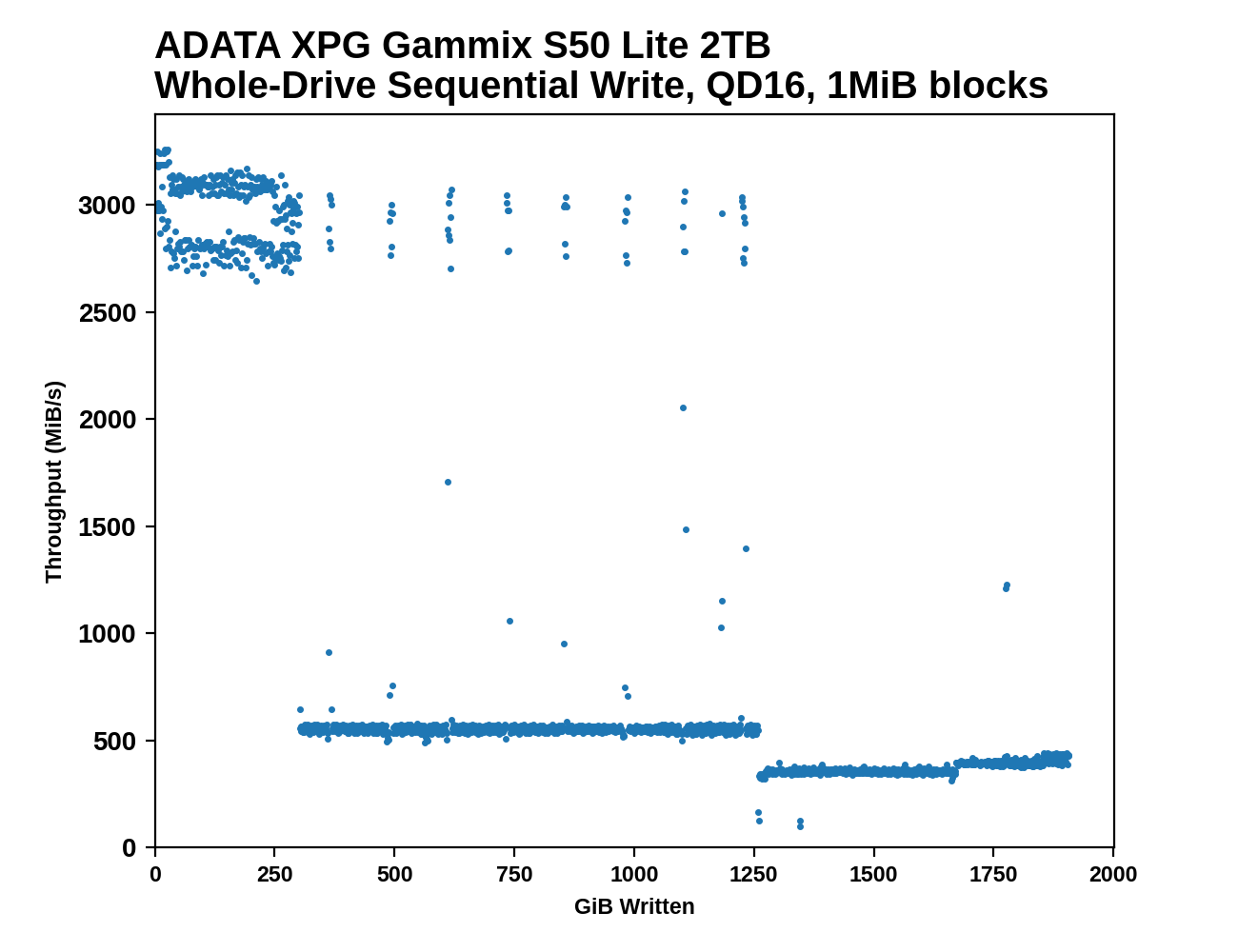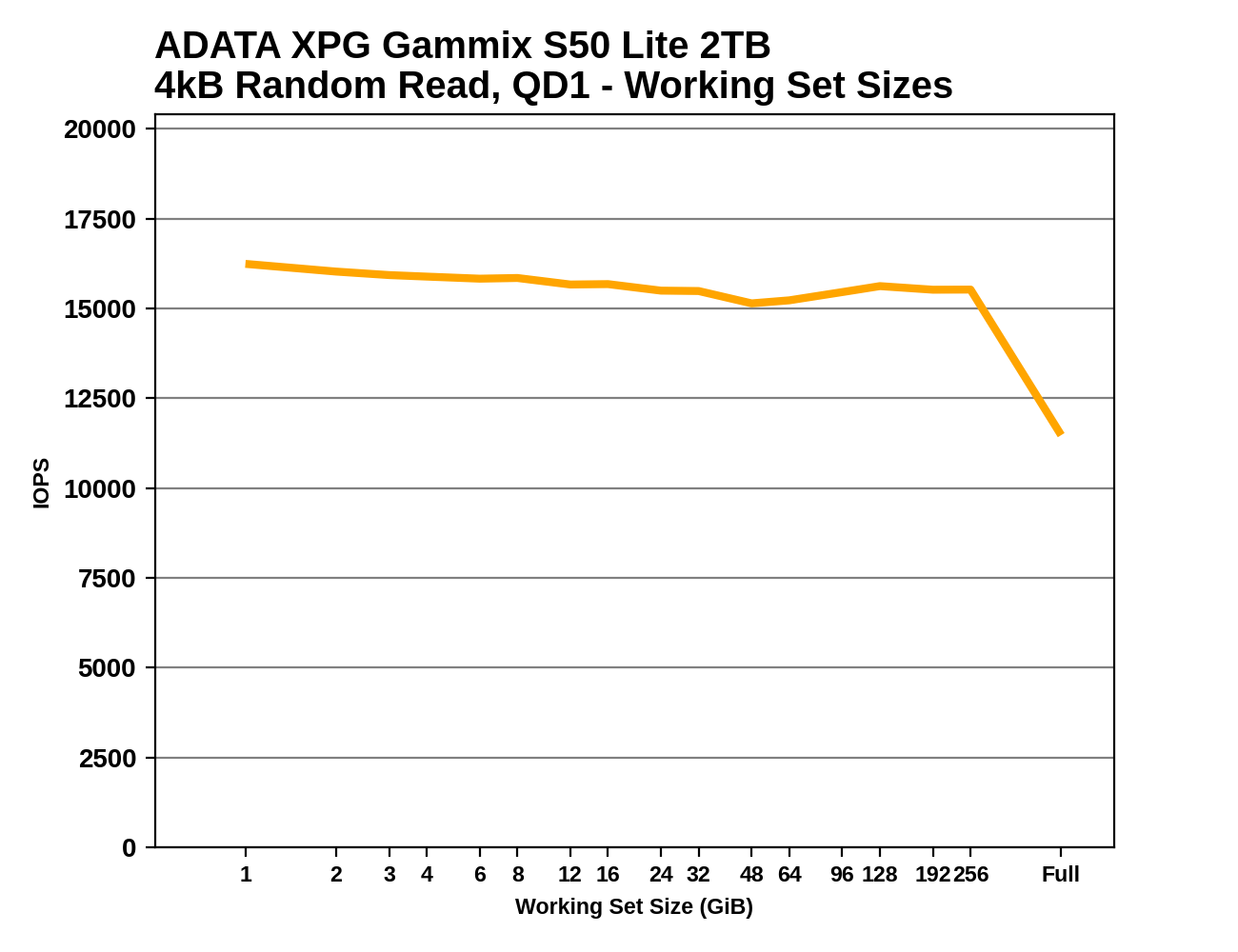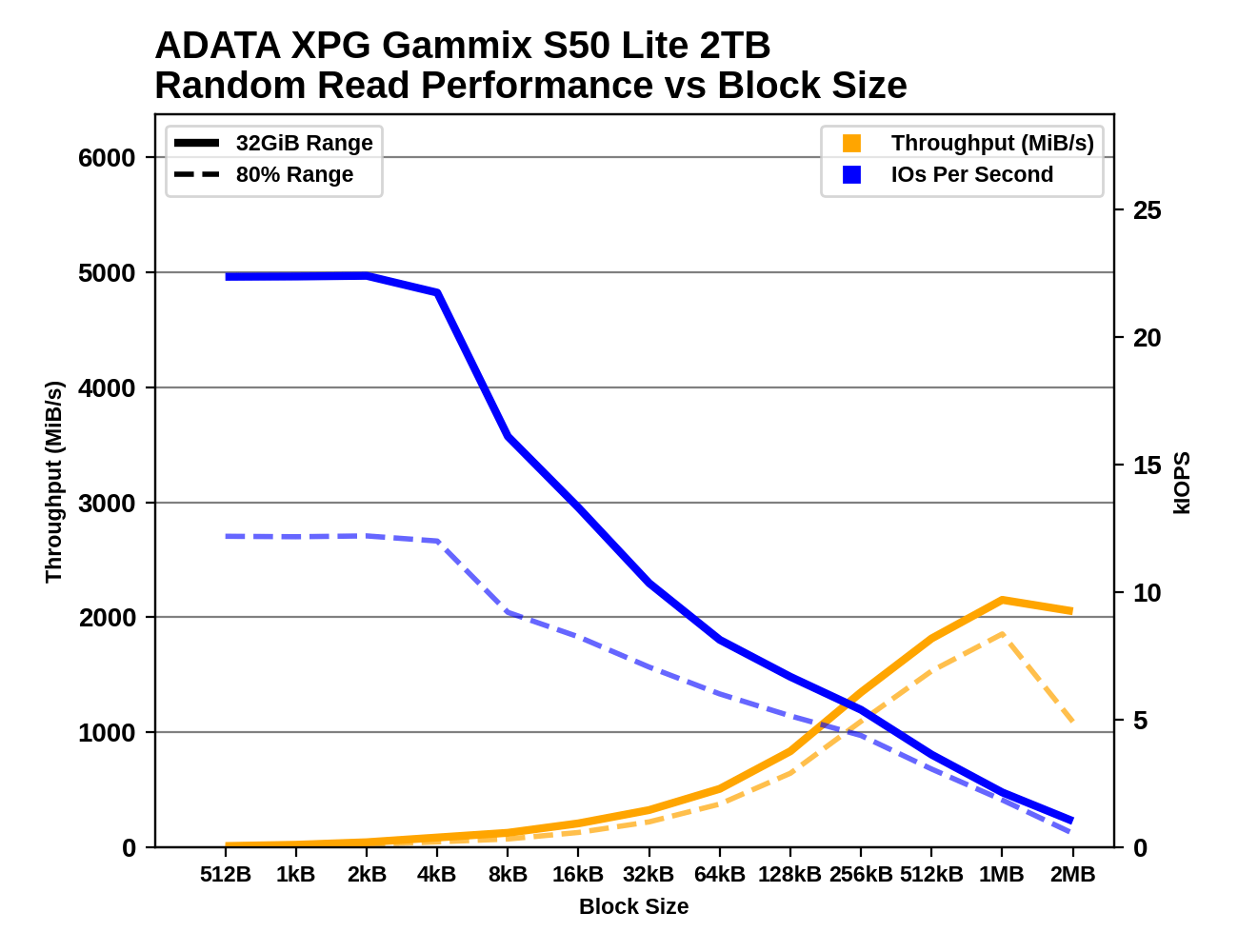The ADATA GAMMIX S50 Lite 2TB SSD Review: Mainstream PCIe Gen4
by Billy Tallis on April 30, 2021 8:00 AM ESTAdvanced Synthetic Tests
Our benchmark suite includes a variety of tests that are less about replicating any real-world IO patterns, and more about exposing the inner workings of a drive with narrowly-focused tests. Many of these tests will show exaggerated differences between drives, and for the most part that should not be taken as a sign that one drive will be drastically faster for real-world usage. These tests are about satisfying curiosity, and are not good measures of overall drive performance. For more details, please see the overview of our 2021 Consumer SSD Benchmark Suite.
Whole-Drive Fill
 |
|||||||||
| Pass 1 | |||||||||
| Pass 2 | |||||||||
The ADATA XPG Gammix S50 Lite shows an almost QLC-like performance drop when the SLC cache runs out after about 300GB: it falls down to SATA speeds. But even though its post-cache write speed is half of what we're used to seeing from TLC drives (most of which use controllers with 8 channels rather than 4), the S50 Lite still has a big lead over the two QLC drives in this bunch.
On the second pass of filling the drive, the S50 Lite's SLC cache is good for only about 14GB and the post-cache performance is much less consistent, with frequent drops below 100MB/s and spikes back up to SLC speeds around 3GB/s.
 |
|||||||||
| Average Throughput for last 16 GB | Overall Average Throughput | ||||||||
Working Set Size
 |
|||||||||
The S50 Lite has excellent random read latency for smaller working sets, beating all but two of the drives in this bunch. But the consequences of having only 1GB of DRAM for a 2TB drive show up at the end of the test, where the random read performance falls off sharply once the reads span the entire drive rather than just a small slice.
Performance vs Block Size
 |
|||||||||
| Random Read | |||||||||
| Random Write | |||||||||
| Sequential Read | |||||||||
| Sequential Write | |||||||||
The S50 Lite offers the same random read IOPS for all the IO block sizes from 512 bytes up to 4kB, but when testing random writes there's a clear preference for 4kB block sizes rather than anything smaller. Rather surprisingly, sequential reads with 4kB block sizes are far slower than for slightly smaller or larger block sizes; it would appear that the drive assumes 4kB reads will be random IO, and skips whatever caching or prefetching is active when using other block sizes.










93 Comments
View All Comments
Dizoja86 - Saturday, May 1, 2021 - link
I was also confused about that. The price seems fair for the performance.Dizoja86 - Saturday, May 1, 2021 - link
Really hoping to see that S70 review soon. From the SSD recommendations for this month, it sounds like it's in the works.Billy Tallis - Saturday, May 1, 2021 - link
I'm currently wrapping up testing of the most recent Innogrit firmware available. Over the weekend I'll be re-testing the 980 PRO with Samsung's newest firmware. Once those tests are complete, I plan to write up my Phison E18 review first, then the ADATA S70.Scour - Sunday, May 2, 2021 - link
Would be nice :)Dug - Wednesday, May 5, 2021 - link
From looking at others like storage review, I wouldn't even be looking at that drive.Nexing - Saturday, May 1, 2021 - link
'we had originally speculated that the SM2267 controller might allow the S50 Lite to be the first Gen4 SSD suitable for laptop usage (hoping for similar power efficiency to the SK hynix Gold P31)'What about?
Sabrent 1TB Rocket 4 Plus NVMe 4.0 Gen4 PCIe M.2 Internal SSD Extreme Performance Solid State Drive (SB-RKT4P-1TB)
Billy Tallis - Saturday, May 1, 2021 - link
The Rocket 4 Plus is a Phison E18 drive. That's an 8-channel controller designed for maximum performance. That kind of goal usually leads to mediocre power efficiency at best. And our testing shows that the E18 doesn't even have great efficiency among current top of the line Gen4 controllers. For example, an E18 drive against the WD Black SN850 loses in all but one of the efficiency scores: https://www.anandtech.com/bench/product/2783?vs=27...And against the SK hynix Gold P31, the E18 drive loses very badly on efficiency, with the P31 typically getting somewhere around 3x better performance per Watt: https://www.anandtech.com/bench/product/2783?vs=27...
You might be able to run an E18 drive in a laptop, but the extra performance isn't going to make anything feel noticeably faster, and if you have a heavy storage workload that might come close to making use of the drive's theoretical performance, then its poor efficiency will start to have an impact on battery life.
Scour - Sunday, May 2, 2021 - link
I think thermal throttling in laptops could be a big problem if using high performance NVME-SSDsTheinsanegamerN - Monday, May 3, 2021 - link
Well duh.Linustechtips12#6900xt - Monday, May 3, 2021 - link
laptops have one big issue, thermal performance, and we have seen let's just call "optimistic" ways of cooling down our silicon chips there will always be problems with thermals and desktops will always be faster just because of thermals period simple as that, I do realize this is very like probably not right in the sense desktops will always outperform laptops but for the foreseeable future, I believe it to be true.